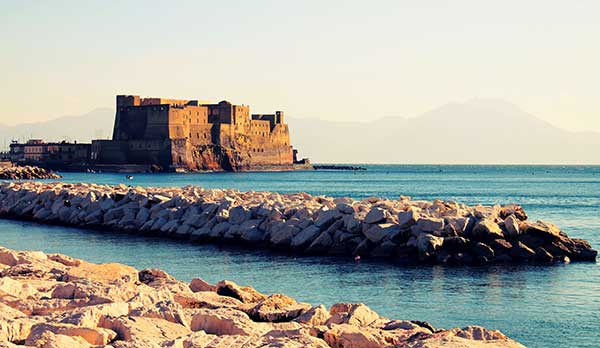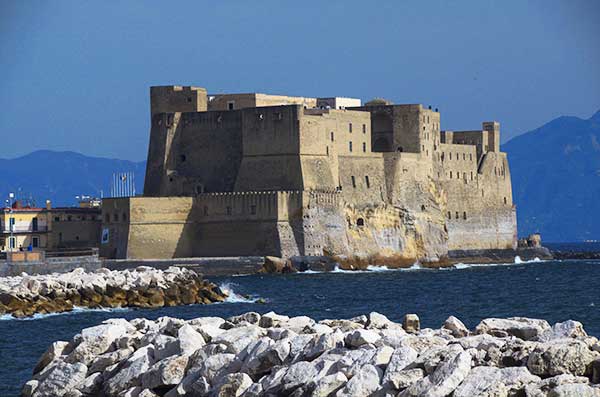
Sull’azzurro lungomare di Napoli, sull’isolotto di Magaride, sembra emergere dall’acqua l’inconfondibile mole del Castel dell’Ovo, la fortezza più antica della città.


Sull’azzurro lungomare di Napoli, sull’isolotto di Magaride, sembra emergere dall’acqua l’inconfondibile mole del Castel dell’Ovo, la fortezza più antica della città.

Questa fortificazione, un tempo isolata dal mare, ha un passato in cui storia e leggenda si mescolano.
Secondo la tradizione popolare il toponimo del Castel dell’Ovo non deriverebbe dalla struttura della sua pianta, che rievoca, con la sua ellisse allungata, la forma di un uovo.
Questa fortificazione, un tempo isolata dal mare, ha un passato in cui storia e leggenda si mescolano.
Secondo la tradizione popolare il toponimo del Castel dell’Ovo non deriverebbe dalla struttura della sua pianta, che rievoca, con la sua ellisse allungata, la forma di un uovo.
La leggenda narra che molti anni fa il castello non esisteva e al suo posto c’era una spiaggia. Proprio lì si rifugiò Partenope, una sirena esausta dopo aver seguito la nave del re guerriero Ulisse. Prima di morire la sirena lasciò un uovo, nel punto in cui ora si erge il castello. Secondo la leggenda l’uovo si trova proprio sotto la costruzione, in una gabbia d’oro, e da esso deriva il nome Castel dell’Ovo. Questo è quanto racconta il poeta latino Virgilio, che amava la storia di Ulisse e in memoria di questa storia disse: fino a quando l’uovo esisterà, Napoli vivrà prospera. Ecco il motivo per cui la sorte dell’uovo magico sarebbe legata a quella della città e, secondo la leggenda, la sua rottura avrebbe provocato il crollo dell’edificio e una serie di catastrofi.
Secondo la storia, invece, nel I secolo a.C. una parte dell’isolotto di “Megaris” fu trasformato nella residenza lussuosa del condottiero romano Lucio Licinio Lucullo.
La costruzione fu munita di fortificazioni già in età prenormanna, anche se il Castel dell’Ovo vero e proprio si deve ai Normanni e a Federico II. Quest’ultimo trasformò la residenza da lussuosa a reale, facendola diventare la sede del tesoro regio. Questa funzione venne mantenuta anche successivamente con gli angioini.
Il castello fortificato, dalle caratteristiche medioevali, andò per gran parte distrutto nel 1503, quando, durante un assedio, Ferdinando il Cattolico lo fece minare.
Il Castello venne ricostruito in forme bastionate dagli spagnoli. A partire dal 1975, quando il Castello venne dismesso dal suo antico uso militare, si ebbero grandi e radicali lavori di ristrutturazione. Il Castel dell’Ovo fu, poi, oggetto di opere di consolidamento che ci hanno consegnato la struttura così come la possiamo ammirare oggi.
La via principale di accesso al Castel dell’Ovo è la rampa di origine normanna.
L’intera fortificazione è fiancheggiata e attraversata, per tutta la lunghezza, da una strada in salita. Da questo punto si ha una veduta spettacolare sul mare e sulla città di Napoli. Inoltre, da qui, è possibile osservare la stratificazione della struttura, evidente in alcune sue parti, come per la Sala delle Colonne e i loggiati di età gotica e aragonese.
All’interno è possibile visitare la Sala delle Colonne, la Chiesa del Salvatore e i loggiati.
Oggi il Castel dell’Ovo è sede della Direzione Regionale per i Beni Culturali e Paesaggistici della Campania. È un luogo adibito a mostre, eventi, convegni e manifestazioni culturali e accoglie, in alcuni ambienti, le raccolte del museo di Etnopreistoria del CAI. Vi si possono ammirare utensili preistorici, fossili, ceramiche e materiale etnografico.
Presso il Castel dell’Ovo c’è il piccolo Borgo marinaro del XIX secolo, che ospita un caratteristico porto turistico, trattorie e caffè sempre frequentati da turisti. Imperdibile è una passeggiata sul lungomare, da percorrere a piedi, partendo da Via Santa Lucia, dove si apre una tipica edicola sacra, dedicata all’omonima Santa, per arrivare fino all’insenatura di Mergellina. Da segnalare la settecentesca fontana dell’Immacolata, opera del Bernini, ubicata all’inizio della litoranea.
Questa fortificazione, un tempo isolata dal mare, ha un passato in cui storia e leggenda si mescolano.
Secondo la tradizione popolare il toponimo del Castel dell’Ovo non deriverebbe dalla struttura della sua pianta, che rievoca, con la sua ellisse allungata, la forma di un uovo.
La leggenda narra che molti anni fa il castello non esisteva e al suo posto c’era una spiaggia. Proprio lì si rifugiò Partenope, una sirena esausta dopo aver seguito la nave del re guerriero Ulisse. Prima di morire la sirena lasciò un uovo, nel punto in cui ora si erge il castello. Secondo la leggenda l’uovo si trova proprio sotto la costruzione, in una gabbia d’oro, e da esso deriva il nome Castel dell’Ovo. Questo è quanto racconta il poeta latino Virgilio, che amava la storia di Ulisse e in memoria di questa storia disse: fino a quando l’uovo esisterà, Napoli vivrà prospera. Ecco il motivo per cui la sorte dell’uovo magico sarebbe legata a quella della città e, secondo la leggenda, la sua rottura avrebbe provocato il crollo dell’edificio e una serie di catastrofi.
Secondo la storia, invece, nel I secolo a.C. una parte dell’isolotto di “Megaris” fu trasformato nella residenza lussuosa del condottiero romano Lucio Licinio Lucullo.


La costruzione fu munita di fortificazioni già in età prenormanna, anche se il Castel dell’Ovo vero e proprio si deve ai Normanni e a Federico II. Quest’ultimo trasformò la residenza da lussuosa a reale, facendola diventare la sede del tesoro regio. Questa funzione venne mantenuta anche successivamente con gli angioini.
Il castello fortificato, dalle caratteristiche medioevali, andò per gran parte distrutto nel 1503, quando, durante un assedio, Ferdinando il Cattolico lo fece minare.
Il Castello venne ricostruito in forme bastionate dagli spagnoli. A partire dal 1975, quando il Castello venne dismesso dal suo antico uso militare, si ebbero grandi e radicali lavori di ristrutturazione. Il Castel dell’Ovo fu, poi, oggetto di opere di consolidamento che ci hanno consegnato la struttura così come la possiamo ammirare oggi.
La via principale di accesso al Castel dell’Ovo è la rampa di origine normanna.
L’intera fortificazione è fiancheggiata e attraversata, per tutta la lunghezza, da una strada in salita. Da questo punto si ha una veduta spettacolare sul mare e sulla città di Napoli. Inoltre, da qui, è possibile osservare la stratificazione della struttura, evidente in alcune sue parti, come per la Sala delle Colonne e i loggiati di età gotica e aragonese.
All’interno è possibile visitare la Sala delle Colonne, la Chiesa del Salvatore e i loggiati.
Oggi il Castel dell’Ovo è sede della Direzione Regionale per i Beni Culturali e Paesaggistici della Campania. È un luogo adibito a mostre, eventi, convegni e manifestazioni culturali e accoglie, in alcuni ambienti, le raccolte del museo di Etnopreistoria del CAI. Vi si possono ammirare utensili preistorici, fossili, ceramiche e materiale etnografico.
Presso il Castel dell’Ovo c’è il piccolo Borgo marinaro del XIX secolo, che ospita un caratteristico porto turistico, trattorie e caffè sempre frequentati da turisti. Imperdibile è una passeggiata sul lungomare, da percorrere a piedi, partendo da Via Santa Lucia, dove si apre una tipica edicola sacra, dedicata all’omonima Santa, per arrivare fino all’insenatura di Mergellina. Da segnalare la settecentesca fontana dell’Immacolata, opera del Bernini, ubicata all’inizio della litoranea.